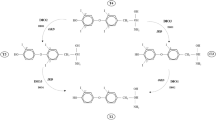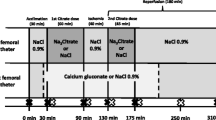Abstract
To evaluate the effect of thyroxin (T4) on recovery from ischemic acute renal failure, rats were treated with T4 (10 or 20 μg/100 g body wt.) or normal saline (NS) either immediately prior to, immediately after or 24 h after 45 min of renal ischemia. Animals given T4 prior to ischemia had no significant increase in Inulin clearance (Cin) (377±40 μl/min per 100 g body wt.) as compared with saline-treated ischemic controls (306±54). In contrast, animals treated immediately after ischemia with either dose of T4 demonstrated significantly better kidney function (Cin 515±59 μl/min per 100 g body wt., Uosm 842±88 mosmol/kg, FENa 0.52%±0.12% and Cin 543±71, Uosm 939±103, FENa 0.48±0.12, for 10 and 20 μg/100 g body wt., respectively). Moreover, the improvement in renal function was sustained and Cin was significantly better at day 3 (748±70) and day 7 (990±75) compared with saline controls (560±30 and 732±45, respectively). Animals which received T4 24 h after ischemia showed significantly higher Cin when compared with ischemic controls. To assess the impact of T4 on recovery of renal ATP,31P-NMR was used. T4-treated rats demonstrated 90%±5% recovery of renal ATP by 120 min of reflow, whereas NS animals had only 64%±1%. In addition, cellular morphology was better preserved in T4 animals. These data indicate that animals treated postischemically with T4 showed accelerated and sustained recovery from acute renal failure. This beneficial effect appears to be related to cellular mechanisms which are essential for the restoration of sublethally injured cells.
Similar content being viewed by others
References
Straub E (1971) Einfluss von Thyroxin auf den Verlauf des akuten Nierenversagens. I. Einfluss der L-Thyroxin-Applikation auf die Letalität von Kaninchen und Mäusen mit manifestem akutem Nierenversagen (Untersuchungen am Modell der sog. Sublimatnephrose) Z Ges Exp Med 154: 177–186
Straub E (1971) Einfluss von Thyroxin auf den Verlauf des akuten Nierenversagens. II. Einfluss der L-Thyroxin-Applikation auf Plasmaspiegel und renale Ausscheidung verschiedener Substanzen bei Kaninchen mit manifestem akutem Nierenversagen (Untersuchungen am Modell der sog. Sublimathephrose). Z Ges Exp Med 155: 32–55
Straub E (1971) Einfluss von Thyroxin auf den Verlauf des akuten Nierenversagens III. Einfluss der L-Thyroxin-Applikation auf die Glomerulumfiltration, den effektiven Nierenplasmastrom und die tubuläre Sekretions- und Rückresorptions-Kapazität von Kaninchen mit toxischem Nierenschaden (Untersuchungen am Modell der sog. Sublimathephrose) Z Ges Exp Med 155: 56–73
Schulte-Wissermann H, Straub E, Funke P (1977) Influence of L-thyroxin upon enzymatic activity in the renal tubular epithelial of the rat under normal conditions and in mercury-induced lesions. Virchows Arch B 23: 163–173
Cronin RE, Brown DM, Simonsen R (1986) Protection by thyroxin in nephrotoxic acute renal failure. Am J Physiol 251: F408–F416
Siegel NJ, Gaudio KM, Katz LA, Feilly HF, Ardito TA, Hendler FG, Kashgarian M (1984) Beneficial effect of thyroxin on recovery from toxic acute renal failure. Kidney Int 25: 906–911
Siegel NJ, Avison MJ, Reilly HF, Alger JR, Shulman RG (1983) Enhanced recovery of renal ATP with postischemic infusion of ATP-MgCl2 determined by31P-NMR. Am J Physiol 245: F530–F534
Siegel NJ, Gaudio KM, Cooper K, Thulin G, Avison M, Stromski M, Kashagarian M, Shulman RG (1985) Accelerating recovery from acute renal failure: exogenous metabolite augmentation. Mol Physiol 8: 593–598
Gaudio KM, Ardito TA, Reilly HF, Kashgarian M, Siegel NJ (1983) Accelerated cellular recovery after an ischemic renal injury. Am J Pathol 112: 338–346
Reimer KA, Ganote CE, Jennings RB (1972) Alterations in renal cortex following ischemic injury. III. Ultrastructure of proximal tubules after ischemia or autolysis. Lab Invest 26: 347–363
Glaumann B, Glaumann H, Berezesky IK, Trump BF (1975) Studies on the pathogenesis of ischemic cell injury. II. Morphology changes of the pars convoluta (P1 and P2) of the proximal tubule of the rat kidney made ischemic in vivo. Virchows Arch Cell Pathol 19: 281–302
Glaumann B, Trump BF (1975) Studies on the pathogenesis of ischemic cell injury. III. Morphological changes of the proximal pars recta tubules (P3) of the rat kidney made ischemic in vivo. Virchows Arch Cell Pathol 19: 303–323
Venkatachalam MA, Bernard DB, Donohoe JF, Levinsky NG (1978) Ischemic damage and repair in the rat proximal tubule: differences among the S1, S2 and S3 segments. Kidney Int 14: 31–49
Vogt MT, Farber E (1968) On the molecular pathology of ischemic renal cell death. Am J Pathol 53: 1–24
Fernando AR, Griffiths JR, O'Donoghue E, Ward JP, Armstrong DMG, Hendry WF, Perrett D, Wickham JEA (1976) Enhanced preservation of the ischemic kidney with inosine. Lancet 1: 555–557
Hems DA, Brosnan JT (1970) Effects of ischemia on content of metabolites in rat liver and kidney in vivo. Biochem J 120: 105–111
Warnick CT, Lazazarus HM (1980) Recovery of nucleotide levels after cell injury. Can J Biochem 59: 116–121
Collins GM, Taft P, Green RO, Ruprecht R, Halasz NA (1981) Adenine nucleotide levels and recovery of function after renal ischemic injury. World J Surg 1: 237–243
Stromski ME, Cooper K, Thulin G, Gaudio KM, Siegel NJ, Shulman RG (1986) Chemical and functional correlates of postischemic renal ATP levels. Proc Natl Acad Sci USA 83: 6142–6145
Stromski ME, Cooper K, Thulin G, Avison MJ, Gaudio KM, Shulman RG, Siegel NJ (1986) Postischemic ATP-MgCl2 provides precursors for resynthesis of cellular ATP in rats. Am J Physiol 250: F834–F837
Hoch FL (1977) Adenine nucleotide translocation in liver mitochondria of hypothyroid rats. Arch Biochem Biophys 178: 535–545
Barbior BM, Creagan S, Ingbar SH, Kipnes RS (1973) Stimulation of mitochondrial adenosine diphosphate uptake by thyroid hormones. Proc Natl Acad Sci USA 170: 98–102
Ballard PL, Hovey ML, Gonzales LK (1984) Thyroid hormone stimulation of phosphatidyl-choline synthesis in cultured fetal rabbit lung. J Clin Invest 74: 898–905
Lo CS, Edelman IS (1976) Effect of triiodothyronine on the synthesis and degradation of renal cortical (Na++ K+)-adenosine triphosphatase. J Biol Chem 251: 7834–7840
Cronin RE, Newman JA (1985) Protective effect of thyroxin but not parathyroidectomy on gentamicin nephrotoxicity. Am J Physiol 248: F332–339
Avner ED, Sweeney WE, Finegold DN, Piesco NP, Ellis D (1985) Sodium-potassium ATPase activity mediates cyst formation in metanephric organ culture. Kidney Int 28: 447–455
Paller MS, Sikora JJ (1986) Hypothyroidism protects against free radical damage in ischemic acute renal failure. Kidney Int 29: 1162–1166
Author information
Authors and Affiliations
Rights and permissions
About this article
Cite this article
Sutter, P.M., Thulin, G., Stromski, M. et al. Beneficial effect of thyroxin in the treatment of ischemic acute renal failure. Pediatr Nephrol 2, 1–7 (1988). https://doi.org/10.1007/BF00870370
Received:
Revised:
Accepted:
Issue Date:
DOI: https://doi.org/10.1007/BF00870370




